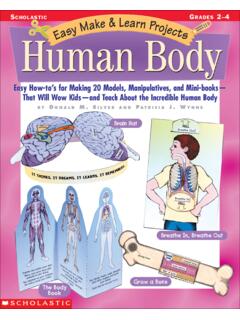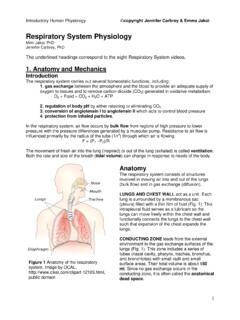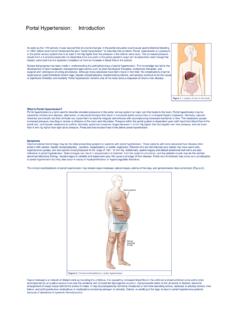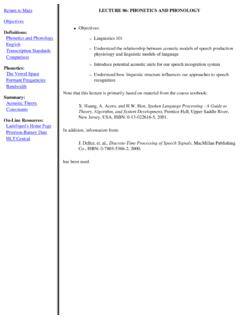Transcription of Introduction to CFD Basics - Cornell University
1 Introduction to CFD Basics Rajesh Bhaskaran Lance Collins This is a quick-and-dirty Introduction to the basic concepts underlying CFD. The con- cepts are illustrated by applying them to simple 1D model problems. We'll invoke these concepts while performing case studies in FLUENT. Happily for us, these model-problem concepts extend to the more general situations in the case studies in most instances. Since we'll keep returning to these concepts while performing the FLUENT case studies, it's worth your time to understand and digest these concepts. We discuss the following topics briefly. These topics are the minimum necessary to perform and validate the FLUENT calculations to come later.
2 1. The Need for CFD. 2. Applications of CFD. 3. The Strategy of CFD. 4. Discretization Using the Finite-Difference Method 5. Discretization Using The Finite-Volume Method 6. Assembly of Discrete system and Application of Boundary Conditions 7. Solution of Discrete system 8. Grid Convergence 9. Dealing with Nonlinearity 10. Direct and Iterative Solvers 11. Iterative Convergence 12. Numerical Stability 13. Turbulence modeling 1. The Need for CFD. Applying the fundamental laws of mechanics to a fluid gives the governing equations for a fluid. The conservation of mass equation is . + ( V~ ) = 0. t and the conservation of momentum equation is V~.
3 + (V~ )V~ = p + ~g + ij t These equations along with the conservation of energy equation form a set of coupled, non- linear partial differential equations. It is not possible to solve these equations analytically for most engineering problems. However, it is possible to obtain approximate computer-based solutions to the governing equations for a variety of engineering problems. This is the subject matter of Computational Fluid Dynamics (CFD). Applications of CFD. CFD is useful in a wide variety of applications and here we note a few to give you an idea of its use in industry. The simulations shown below have been performed using the FLUENT.
4 Software. CFD can be used to simulate the flow over a vehicle. For instance, it can be used to study the interaction of propellers or rotors with the aircraft fuselage The following figure shows the prediction of the pressure field induced by the interaction of the rotor with a helicopter fuselage in forward flight. Rotors and propellers can be represented with models of varying complexity. The temperature distribution obtained from a CFD analysis of a mixing manifold is shown below. This mixing manifold is part of the passenger cabin ventilation system on the Boeing 767. The CFD analysis showed the effectiveness of a simpler manifold design without the need for field testing.
5 2. Bio-medical engineering is a rapidly growing field and uses CFD to study the circulatory and respiratory systems. The following figure shows pressure contours and a cutaway view that reveals velocity vectors in a blood pump that assumes the role of heart in open-heart surgery. CFD is attractive to industry since it is more cost-effective than physical testing. However, one must note that complex flow simulations are challenging and error-prone and it takes a lot of engineering expertise to obtain validated solutions. The Strategy of CFD. Broadly, the strategy of CFD is to replace the continuous problem domain with a discrete domain using a grid.
6 In the continuous domain, each flow variable is defined at every point in the domain. For instance, the pressure p in the continuous 1D domain shown in the figure below would be given as p = p(x), 0 < x < 1. In the discrete domain, each flow variable is defined only at the grid points. So, in the discrete domain shown below, the pressure would be defined only at the N grid points. pi = p(xi ), i = 1, 2, .. , N. Continuous Domain Discrete Domain 0 x 1 x = x1, x2, ,xN. x=0 x=1 x x xN. 1 i Grid point Coupled PDEs + boundary Coupled algebraic eqs. in conditions in continuous discrete variables variables In a CFD solution, one would directly solve for the relevant flow variables only at the grid points.
7 The values at other locations are determined by interpolating the values at the grid points. The governing partial differential equations and boundary conditions are defined in terms of the continuous variables p, V~ etc. One can approximate these in the discrete domain in terms of the discrete variables pi , V~i etc. The discrete system is a large set of coupled, algebraic equations in the discrete variables. Setting up the discrete system and solving it (which is a matrix inversion problem) involves a very large number of repetitive calculations, a task we humans palm over to the digital computer. 3. This idea can be extended to any general problem domain.
8 The following figure shows the grid used for solving the flow over an airfoil. We'll take a closer look at this airfoil grid soon while discussing the finite-volume method. Discretization Using the Finite-Difference Method To keep the details simple, we will illustrate the fundamental ideas underlying CFD by applying them to the following simple 1D equation: du + um = 0; 0 x 1; u(0) = 1 (1). dx We'll first consider the case where m = 1 when the equation is linear. We'll later consider the m = 2 case when the equation is nonlinear. We'll derive a discrete representation of the above equation with m = 1 on the following grid: x=1/3.
9 X1=0 x2=1/3 x3=2/3 x4=1. This grid has four equally-spaced grid points with x being the spacing between successive points. Since the governing equation is valid at any grid point, we have ! du + ui = 0 (2). dx i where the subscript i represents the value at grid point xi . In order to get an expression for (du/dx)i in terms of u at the grid points, we expand ui 1 in a Taylor's series: ! du ui 1 = ui x + O( x2 ). dx i Rearranging gives ! du ui ui 1. = + O( x) (3). dx i x 4. The error in (du/dx)i due to the neglected terms in the Taylor's series is called the truncation error. Since the truncation error above is O( x), this discrete representation is termed first- order accurate.
10 Using (3) in (2) and excluding higher-order terms in the Taylor's series, we get the following discrete equation: ui ui 1. + ui = 0 (4). x Note that we have gone from a differential equation to an algebraic equation! This method of deriving the discrete equation using Taylor's series expansions is called the finite-difference method. However, most commercial CFD codes use the finite-volume or finite-element methods which are better suited for modeling flow past complex geometries. For example, the FLUENT code uses the finite-volume method whereas ANSYS uses the finite-element method. We'll briefly indicate the philosophy of the finite-volume method next but will keep using the finite-difference approach to illustrate the underlying concepts which are very similar between the different approaches with the finite-difference method being easiest to understand.








